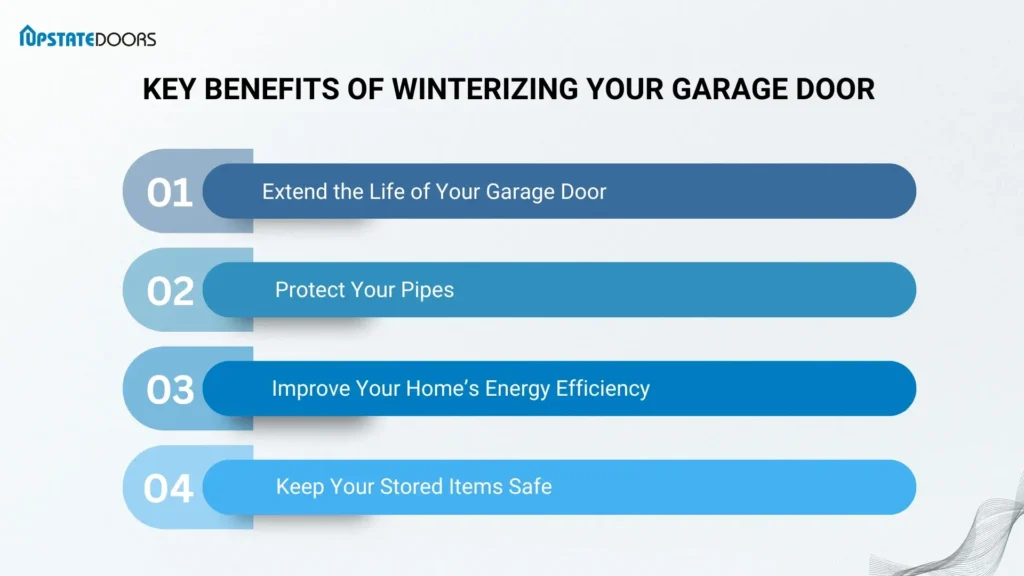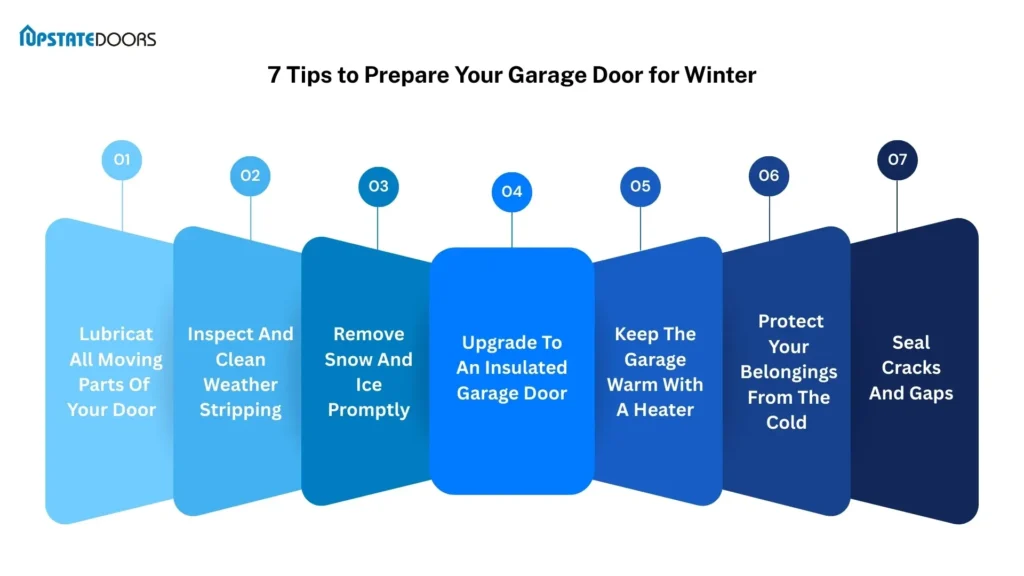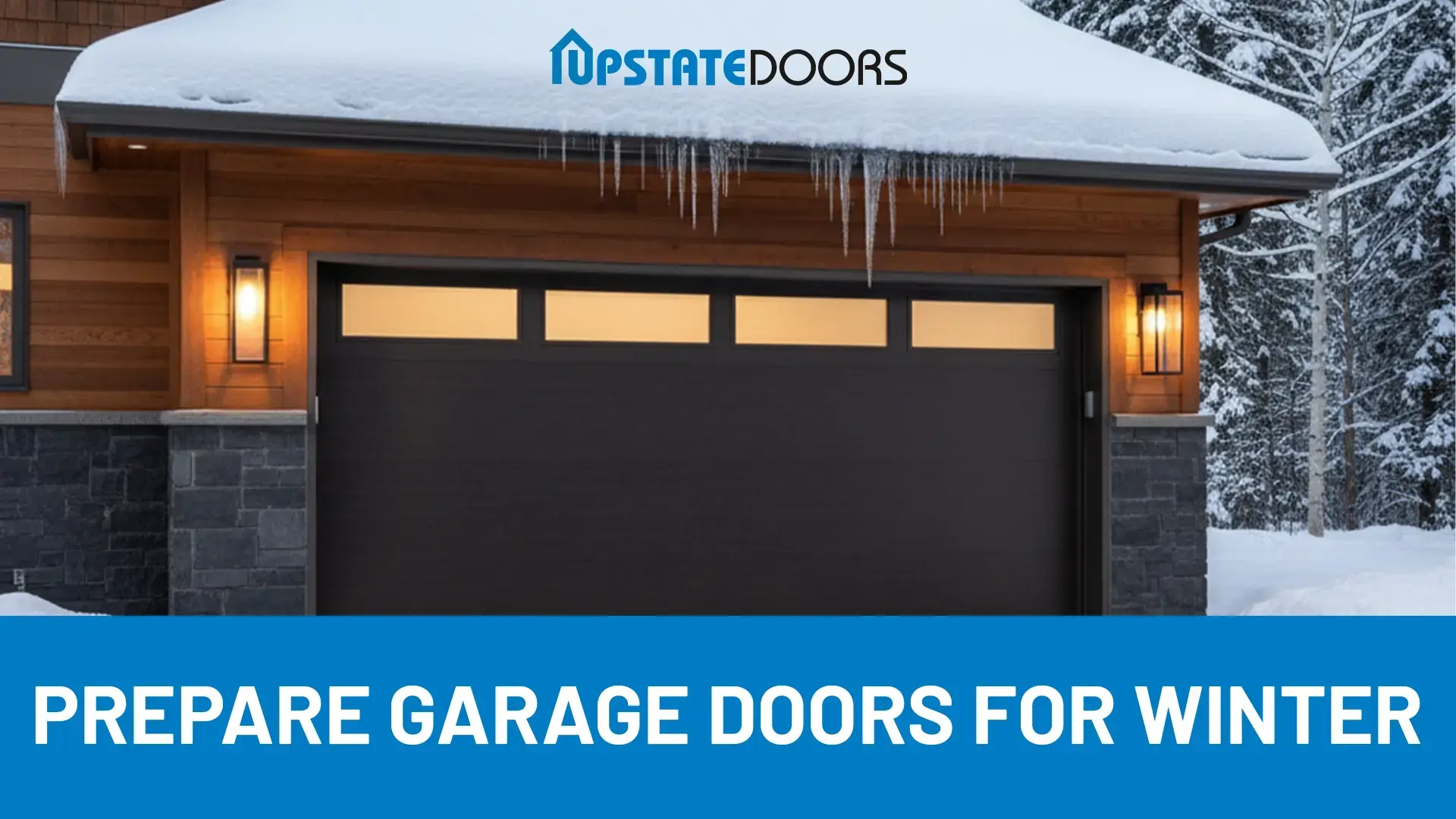Did you know your garage door faces extra strain once freezing temperatures and snow arrive? Cold weather can make parts harder to move, weaken the springs, and even cause the door to get stuck.
Instead of waiting for a breakdown in the middle of winter, you can take action now. Simple checks and quick fixes keep your garage door running smoothly and save you from expensive repairs later.
In this article, you’ll learn 7 practical tips to prepare your garage door for winter weather. These steps are easy, practical, and designed to keep your home safe, warm, and running smoothly in all seasons.
Key Takeaways
- Winterizing your garage door helps keep your home warm, lowers heating costs, and protects your garage and stored items from cold, moisture, and damage.
- Essential steps include checking and tightening hardware, maintaining weatherstripping, lubricating moving parts, testing the balance, and keeping sensors clean to ensure smooth and safe operation during winter.
- Upstate Doors offers expert guidance and professional services to inspect, maintain, or repair your garage door for dependable performance all season long.
Why Preparing Your Garage Door for Winter Is Important

As winter approaches, most homeowners focus on insulation, heating, and snow removal. But your garage door often gets overlooked.
Preparing your garage door for cold weather is more than just a maintenance task. It protects your home, saves money, and prevents unexpected problems.
Here are four key benefits of winterizing your garage door.
1. Extend the Life of Your Garage Door
Your garage door is one of the most used parts of your home. It opens and closes multiple times every day. Over time, this constant use can lead to wear and tear.
Regular maintenance and winter preparation keep the door operating smoothly. This reduces the risk of breakdowns. It also helps you avoid the high cost of replacing the door prematurely.
2. Protect Your Pipes
Many homes have water pipes running through the garage. Cold air can put these pipes at risk of freezing or bursting.
A burst pipe can cause costly water damage to your garage and its contents. Preparing your garage door for winter helps maintain a warmer environment. This reduces the risk of frozen pipes and keeps your home safe from plumbing problems.
3. Improve Your Home’s Energy Efficiency
A properly insulated garage door keeps cold air out and warmth in. Unsealed doors can let freezing air seep into your garage and even your living space.
This forces your heating system to work harder. Winterizing your garage door improves insulation, lowers energy bills, and keeps your garage and home comfortable throughout the season.
4. Keep Your Stored Items Safe
Winter brings snow, moisture, and condensation. These can damage items stored in your garage.
Tools, boxes, seasonal decorations, and even shoes can suffer from damp conditions. Winterizing your garage door helps maintain a dry, protected space. This keeps your belongings safe from moisture damage and mold growth.
7 Tips to Prepare Your Garage Door for Winter

Preparing your garage door for winter can prevent costly repairs and keep it running smoothly in cold weather. Follow these 7 expert tips from Upstate Doors to ensure your door stays safe, efficient, and reliable all season:
1. Lubricate All Moving Parts of Your Door
One of the easiest ways to get your garage door ready for winter is to lubricate the garage door‘s moving parts. Cold temperatures can make metal components stiff, so adding lubricant ensures everything continues to operate smoothly.
- Tracks: Steel tracks can contract or crack in extreme cold. Lubrication provides a protective layer to prevent damage.
- Torsion springs: These springs bear a lot of weight and are prone to rust. A light coat of lubricant keeps them flexible and functional.
- Rollers: Lubricating rollers helps them glide along the tracks without sticking or squeaking.
- Hinges: Apply lubricant at each pivot point so the door opens and closes freely.
2. Inspect and Clean Weather Stripping
Weather stripping seals gaps around your garage door, keeping out cold air, snow, and moisture. Check it carefully for cracks, tears, or worn areas.
- Remove dirt, dust, and debris that may prevent the stripping from forming a tight seal.
- If the weather stripping is damaged or too worn, replace it completely to maintain insulation and protect your garage interior.
3. Remove Snow and Ice Promptly
Heavy snow and ice can put significant pressure on your garage door. After a snowfall, make sure to clear the area around the door and keep it free of accumulation.
- Letting snow sit too long can cause cracks, warping, or rust.
- Moisture from melting snow can damage metal components and wooden parts.
- Regularly sweeping snow away helps your door function properly and extends its lifespan.
4. Upgrade to an Insulated Garage Door
If your garage faces harsh winter temperatures, add insulation to keep the space warmer in winter and cooler in summer.
This step is especially helpful if your garage connects to your home because it can also lower your energy bills and protect stored items from extreme cold.
Types of Garage Door Insulation
- Foam Board Panels: Lightweight, affordable, and easy to cut to fit each panel. Install them with adhesive for a quick and effective solution.
- Reflective Insulation: Reflects heat into the garage door, which keeps the garage door warmer in winter and cooler in summer. It works well in regions with big temperature swings.
- Fiberglass Insulation: Offers strong thermal protection but must be properly covered to avoid irritating skin or lungs.
For the best results, consider installing a pre-insulated garage door. Professionals at Upstate Doors can guide you in choosing a door that keeps your garage comfortable and energy-efficient year-round.
5. Keep the Garage Warm with a Heater
Install a garage heater to maintain a stable temperature throughout winter. Choose an electric, propane, or natural gas heater based on your garage size and budget.
- Electric Heaters: Easy to install and safe for most garages.
- Propane or Natural Gas Heaters: Provide more heat but require proper ventilation to prevent carbon monoxide buildup.
A warm garage protects your door and stored items to make your workspace comfortable during winter weather.
6. Protect Your Belongings from the Cold
Winter can damage your tools, tires, and stored items. Take steps to protect them.
- Metal Tools: Store them on shelves, pegboards, or in tool chests off the floor. Apply a thin coat of oil or use silica packets to prevent rust.
- Paint and Liquids: Keep them off cold concrete floors or move them to a heated area to prevent freezing.
- Tires: Store seasonal tires in bags or covers and keep them off the floor to prevent cracking from temperature changes.
7. Seal Cracks and Gaps
Even small cracks in your garage walls or gaps around windows can let cold air in. Over time, this lowers the temperature inside your garage and puts your stored items at risk.
Fill wall cracks with exterior caulk, seal window frames, and add insulation in outlet spaces. This keeps your garage warm and protects your items.
To check overhead door seals, inspect the bottom and sides of your garage door. Finally, replace worn seals to block drafts and keep your home warmer.
Winter Garage Door Maintenance Tips
Winter isn’t the only time to care for your garage door, but it’s one of the best opportunities to make sure everything is running smoothly.
Along with checking and maintaining weather stripping and applying lubricant each year, there are several steps you can take to ensure your garage door works reliably throughout the cold months.
Test the Door’s Balance
An unbalanced garage door puts extra strain on your opener, which can shorten its lifespan and affect performance.
To check your door, disconnect it from the opener and lift it manually up and down. Make sure the tracks are clear of any obstruction. Then, raise the door to the halfway point and let go.
If it stays steady with only slight movement, the door is balanced. If it falls or rises quickly, the springs may need attention.
Tighten Loose Hardware
Winter weather causes metal parts to expand and contract, which can loosen bolts and screws over time.
Go through all brackets, hinges, and fasteners, and tighten anything that feels loose. This simple step prevents rattling, misalignment, and potential damage to your garage door during heavy use.
Keep the Sensors Free From Debris
Your garage door’s sensors prevent it from closing on objects, pets, or children. These safety features only work if the sensors are clean and unobstructed.
Check the lenses regularly for dust or dirt, and remove leaves, snow, or other debris from the base of the door. This ensures the door closes safely and reliably every time.
Keep Batteries Charged
Operating your garage door in cold weather can drain remote and keypad batteries faster than usual. Before winter arrives, check all batteries and replace or recharge them as needed. This ensures your door always responds when you need it.
Contact Upstate Doors for Expert Garage Service
You can handle many garage door maintenance tasks at home, but some repairs require an expert. Springs and cables, for example, carry extreme tension and can cause serious injury if handled incorrectly.
If your garage door shows signs of wear, makes unusual noises, or struggles to open and close, call a professional right away. Trying to fix high-tension parts yourself can damage your door or put you at risk.
At Upstate Doors, we inspect, maintain, and repair garage doors all year long. Our team keeps your door running smoothly and safely.
For expert garage door services and maintenance, contact Upstate Doors. We handle the hard work so you do not have to.
Final Thoughts
Follow these winterizing tips, such as lubricating moving parts, sealing out drafts, checking the springs, and clearing away snow, to keep your garage door running smoothly all season.
And if you ever need any help, Upstate Doors is here for you. Our team of friendly experts is ready to tune up your door or fix any winter-related issues so your home stays safe and comfortable.
Do not let cold weather get the best of your garage door. With the right prep and a trusted garage door company by your side, you will get through winter with ease.
FAQs
Is it safe to fix high-tension parts like cables or springs on my own?
No. Springs and cables are under extreme tension and can cause serious injury if mishandled.
Should I worry about garage door springs breaking in winter?
Yes. Cold weather puts extra stress on springs, and worn or damaged springs can snap if not maintained.
Should I check my garage door’s weatherstripping before the first snow?
Yes. Inspecting and replacing worn weatherstripping helps prevent drafts, water damage, and energy loss during winter.
Can regular garage door maintenance improve energy efficiency in winter?
Yes. Properly lubricated parts, tight seals, and smooth operation help keep your garage insulated and reduce heat loss.


